1980 Dutch Grand Prix race report
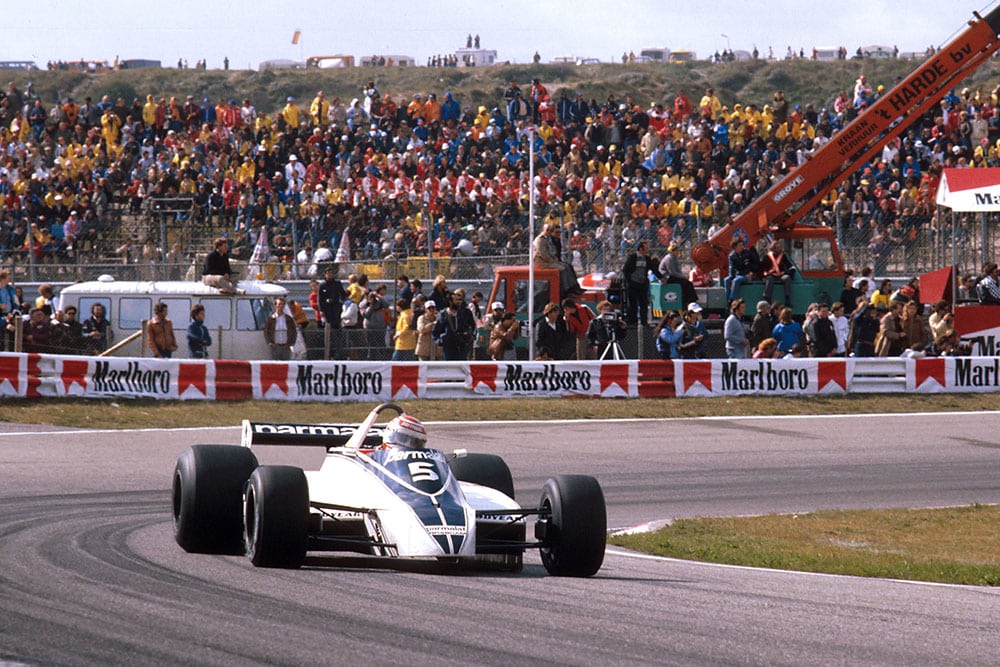
Nelson Piquet claimed a second win of the season for Brabham
Motorsport Images
— A very good race Zandvoort, August 31st
AFTER the FOCA bosses had managed to raise the price of their “Circus” this year, the promoters of the Dutch Grand Prix went ahead and organised their race at Zandvoort. As the Formula One world assembled in the main paddock on Thursday, the overall scene was one of greyness and gloom. At the best of times the North Sea looks mud-coloured, and the seaside bucket-and-spade aspect of Zandvoort is only brightened by artificial light and tinsel. When the sky is mud-coloured and meets the sea in an unbroken line, Zandvoort is not the best place to be.
Qualifying
Friday morning was grey and cool, with a fresh breeze blowing down the main straight, but at least it was dry and looked like staying that way. A scan along the pits before the morning test-session began showed some interesting things and some changes. The McLaren team had their brand-new M.30 car for Prost to drive (see notes on the cars), Alfa Romeo had put Vittorio Brambilla into car number 22, the number previously used by poor Patrick Depailler. Jochen Mass was still suffering from the bruises sustained in his practice accident in Austria a fortnight earlier, but was planning to race for the Arrows team nonetheless. *In our article reporting the German Grand Prix in the September issue of MOTOR SPORT there appeared a sentence referring to The Arrows Team. The reference was published by us on information that we have ascertained and now recognise was totally untrue and we accept that there is no foundation for the said reference and the imputations contained therein, and we regret that it was ever made. We are glad to take the earliest opportunity of correcting our error and of expressing to all members of The Arrows Team our apologies and regret of any distress or embarrassment caused to them by the said original article.* ATS had a brand new D4 model to replace D4/02 which had been destroyed in a testing accident at Silverstone. Lotus were still running a three-car team. Renault were smiling when they heard people talk about “equality now we’re at sea-level”. Ligier were anxiously fingering their Goodyear tyres, hoping they were the right ones (they will be on Michelin next year, in all probability), the Williams team had their Union Jack and Saudi Arabian flags flying strongly in the breeze in front of their pits and Ensign had both their cars ready to go, with Geoff Lees recruited into the team alongside the local lad Jan Lammers. Before things got under scan officially Jean-Pierre Jabouille was doing some filming with a camera mounted behind the cockpit. There were 28 drivers ready to “race” for 24 places on the grid, the question not being one of “who was going to get in” but more of “who was going to be left out.”
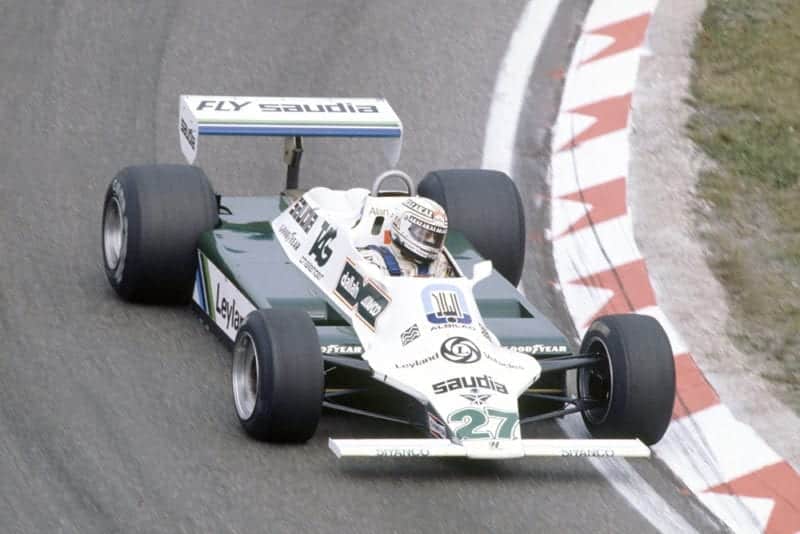
Alan Jones qualified his Williams in 4th
© Motorsport Images
The cars hadn’t been running long before there was a flurry down at the Tarzan hairpin as a McLaren ploughed across the run-off area into the barriers. It was John Watson, whose brakes had apparently failed as he went into the corner, and he was lucky to escape with only a shaking. It wasn’t McLaren’s morning as the new car had been held up while a 200 p.s.i oil pressure in the Nicholson Cosworth V8 was investigated; the oil pressure release valve had stuck and it meant lifting the car up onto trestles while mechanics worked away underneath. During the hiatus while Watson’s wrecked car was collected, Piquet’s Brabham was towed in as the engine had broken. Everything got under way again and continued uninterrupted for the allotted time, nothing startling happening, but everyone was getting settled in for the afternoon timed session. Spare cars were tried out, tyres checked, springs changed, aerodynamic devices adjusted and altered, anti-roll bars changed, and so on. Jochen Mass decided to opt out of the event as he was still suffering from the after-effects of his Austrian accident and was finding the pounding incurred by today’s hard springing was affecting his vision and almost causing “black-out”. Standing in the Tyrrell pits was young Mike Thackwell, watching the overall scene preparatory to having a drive in a third Tyrrell in the North American races. The Arrows team manager wasted no time in co-opting the young lad and fitting him into one of their cars.
Due to various delays in the morning the afternoon timed hour started twenty-live minutes late, but it allowed the Arrows mechanics to re-adiust everything for both their drivers. Patrese’s engine had blown up in the morning an he was being fitted into the spare car, while Thackwell was being fitted into the car vacated by the burly Mass. It wasn’t long before Daly was into the Tyrrell pit for new side-skirts, having damaged them over kerbs, which was a tiresome repeat of what he’d done in the morning, so that his maintenance bill was mounting up. Brakes were taking a hammering at the end of the straight for with improved cornering power and improved adhesion with the latest tyres the drivers could go deeper and deeper into the braking area. Any number of cars were arriving back at the pits with smouldering brake pads and very hot discs. There were no real surprises at the important end of the field, the Renaults, the Williams and the lone charger of the Brabham team, setting the pace, with Giacomelli doing some spirited driving in the Alfa Romeo. The Ligier team were not right up the front, there being dark mutterings about not being able to obtain the Goodyear tyres they really wanted. Their driver’s description of how the cars handled sounded a bit like the Ferrari drivers when describing their Michelin tyres. The Williams team and Piquet had no complaints about their Goodyear tyres, and the Renault drivers were very happy with their Michelin tyres. All tyres look the same, but some seem better suited to some cars than do others!
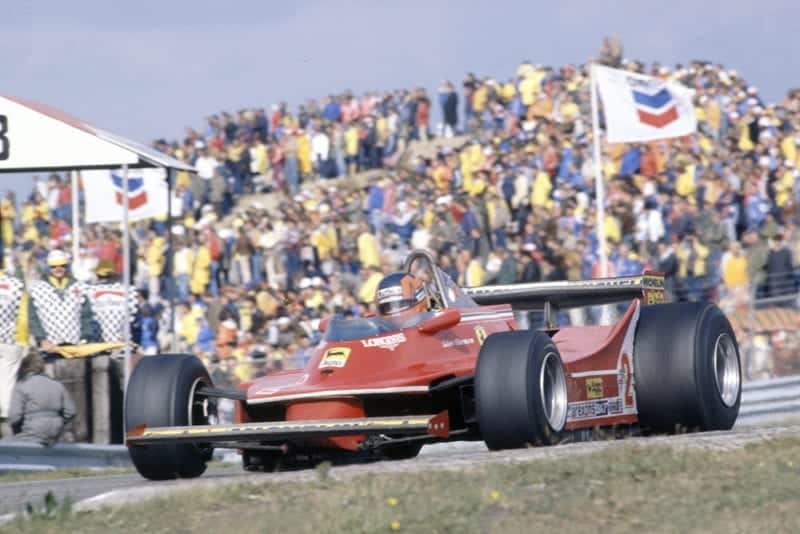
Gilles Villeneuve showed improved qualifying form with 7th fastest time
© Motorsport Images
The two Renault drivers were never seriously challenged, there being little wrong with the cars, the engines, the tyres, or anything else and were all smiles at being able to set the pace even at sea-level, where their turbo-chargers were not supposed to have an unfair advantage over the atmosphere 3-litre engines. It was Arnoux ahead of Jabouille all the way, with Reutemann, Jones and Piquet bunched up together behind the “turbo-twins”. Jones tried the T-car as well as his own, and actually recorded his best time in it; then he switched back to his own car. Piquet had no option but to use the spare Brabham, as his own was having its engine changed. There was gloom in the Fittipaldi pit for Rosberg had crashed in F8/1, not due to his exuberant driving this time, but due to a front suspension failure, and the car was too badly damaged to repair on the spot. They were not the only team to suffer a breakage, for a rear lower wishbone mounting on the Lotus 81/B had broken and sent Mansell off into the sand, and then a rear hub bearing shaft broke up on 81/3 which de Angelis was driving. Jones came slowly into the Williams pit with his throttle linkage adrift, had it fixed and roared off again, still chasing that elusive two-hundreths of a second which would move him ahead of his team-mate and up into third position. He took the right-hand bend behind the pits in his usual manner, on full-throttle, took his foot off the accelerator and onto the brakes in the split second available as the car went from the left of the road to the right, to line up for the left-hand hairpin, but the throttles did not close immediately and the Williams performed a classic example of the well-known phrase “it flanged the guard-rail-. There was nothing that the Australian could do as the car bounced along the steel rail and with the right front suspension demolished as well as the rear end, he stepped out unscathed, but as he said later “I actually saw stars for a moment”. This was another car beyond immediate repair, and a phone call to Didcot got the test-car crew on its way in a van with the basic ingredients ot FW07B/5 on board.
It had been a hectic day with a McLaren, a Fittipaldi and a Williams hors-de-combat, a number of blown-up Cosworth engines being crated-up in preparation ror “return to sender” and a number of cars being repaired and strengthened. The pace at the front of Formula One is indeed fast and furious these days and there were some pretty sweaty drivers about when it was all over. A cautious John Watson had circulated in the spare McLaren. a slightly awed Mike Thackwell had gone quite well on his first try at Formula One, finding the G-forces on his neck far greater than anything he had over experienced and the heaviness of the Arrows steering almost more than his 19-year-old physique could cope with, and Mansell and Fittipaldi looked as if they were not going to take part in Sunday’s race, unless they found some more speed.
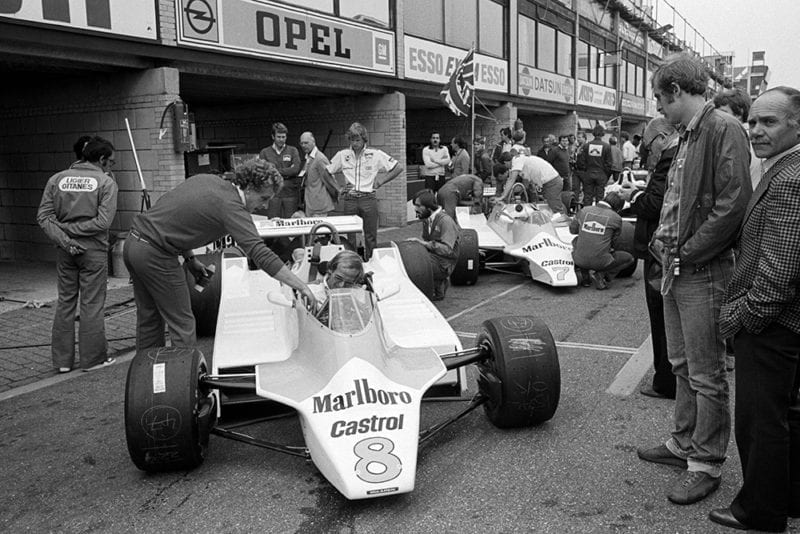
Mechanics work on the McLaren of Alain Prost and John Watson
Motorsport Images
There was rain on Saturday morning, but it did not last and the test-session took place in windy and sunny conditions, or at least it started like that. Piquet was still using the spare Brabham, Laffite was in the spare Ligier and Rosberg was in the old original F7 Fittipaldi. In the paddock the Williams team were building up a new car around the basis of FW07B/5, while the salvageable bits off FW07B/9 were being loaded into the Sherpa van along with the damaged monocoque to be taken back to Didcot straight away, the test-team having driven out overnight with the monocoque and components for FW07B/5. Meanwhile Jones was out in FW07B/7. Reutemann stopped out on the circuit in FW07B/8 when its engine blew up, and there being no spare car he had little option but to stand around doing nothing. Another Cosworth engine blew up, this time in the new McLaren M30, so Prost used M20C/5 and Watson was still in his spare M29C. A squall of rain interrupted the morning activity, but not for long, and when it was over those with nothing to do had lunch, but the Williams and McLaren mechanics set-to to change engines in their stricken cars.
As the wind was getting stronger a number of teams changed gear-ratios and fitted smaller rear aerofoils, to try and get more speed on the straight, without losing anything on the corners. The final hour of timed practice was from 1 p.m. to 2 p.m. and the new McLaren M30 was back in action again, but Reutemann’s Williams was still being finished off. Piquet was back in his own car, Brabham BT49/7, but the spare was on hand for him and had been fitted with a B-specification rear end, which uses a Weismann transverse shaft gearbox, and the suspension to go with it, with the spring units directly behind the gearbox, operated by long rocker arms. All this gave a much clearer path for the air exiting under the car, the Weismann gearbox being tall, but very slim. Rebaque, in BT49/6, had been using this type of rear end all the time, and indeed this car has had the Weismann layout for three races now.
The general consensus of opinion was that the track was slower than yesterday, with the stronger wind blowing fine sand onto the surface, but if this was so nobody told Arnoux, for he went even faster than before. The rebuilt chicane had added about 2 seconds to the lap times, and Arnoux’s best was 1 min. 17.44 secs., compared to his best practice time last year of 1 min. 15.461 secs. None of the other front runners could match their Friday times, though it was not for want of trying. Jones was running with the bare minimum of petrol in the tank and missed his pit signal to come in, setting off on one more lap, but he didn’t complete it for he ran out of petrol on the far side of the circuit. Cursing his luck and wondering what to do he was amazed to find practice had been stopped, and a course car towed him round to the pits! It hadn’t been stopped for him; Geoff Lees had spun his Ensign and marshals were struggling to get him out of the sand, while some of the other drivers were still roaring past at unabated speed in spite of yellow flags. To retrieve the situation the organisers stopped practice and as they did so the Ensign was push-started and roared off! However, the short break was lust the luck that Alan Jones wanted.
Everyone got going again and with barely half-an-hour left the Lotus team fitted Mansell into Andretti’s spare car, 81/2, as he seemed to have reached the limit of the possibilities of the experimental car 81/B and was not fast enough to be in the top twenty-four. Straight away he moved up to sixteenth place, so that Lotus really had to believe that there was a difference in the road-holding of their cars. It seems that there were various versions of side-pods, with different shapes underneath, and they had finally hit on something that gave them an advantage. Andretti and de Angelis were tenth and eleventh, respectively, which was quite good for Lotus these days! A surprise to a lot of people was to see John Watson ahead of the two Lotus cars, in ninth place. He was suffering no after-effects from his Friday accident and claimed that he had now grasped the technique for driving a ground-effect car. Better late than never! Due to the short stoppage practice went on until seven minutes past 2 p.m., but the important part of the scene did not change. The two Renaults were at the front, followed by the two Williams, with Reutemann one hundredth of a second faster than Jones. Even missing the first twenty minutes of this final hour did not deter the Argentinian, he was still a fraction faster than Jones, even though neither of them matched their Friday times. Piquet was in fifth place, and unable to improve on this he gave the spare car a few laps just before the end, but stopped out on the circuit “out of fuel” said the Brabham people, as they pushed the car through the paddock with the rear end on a trolley-jack!
While Ligier were grumbling about their tyres not providing the predictable adhesion they had become used to, Ferrari were actually quite pleased with their Michelins for a change, and Villeneuve responded with seventh place on the grid, while Scheckter was twelfth. Rosberg had found the old Fittipaldi hopeless and gave up trying, Thackwell went quite well at his first try, but not well enough, Lammers just could not get any results from the Ensign on his home track. and Keegan improved over his previous time, but not by enough, so these four were the ones who were to be spectators on the morrow. The Renault team were grinning contentedly, happy with their Michelin tyres, satisfied at the performance of their turbo-charged V6 engines at sea-level, and having no complaints about their road-holding or anything else. They were listening for the cries from their competitors of “ban the turbo-charger”, but there weren’t any. The Ferrari turbo-charged engine is imminent, Alfa Romeo are quietly working away, the Brabham team are using turbo-charged BMW engines next year and the best rumour of the weekend was that Cosworth Engineering were going to put the V6 Renault engine into production for general sale.
Race
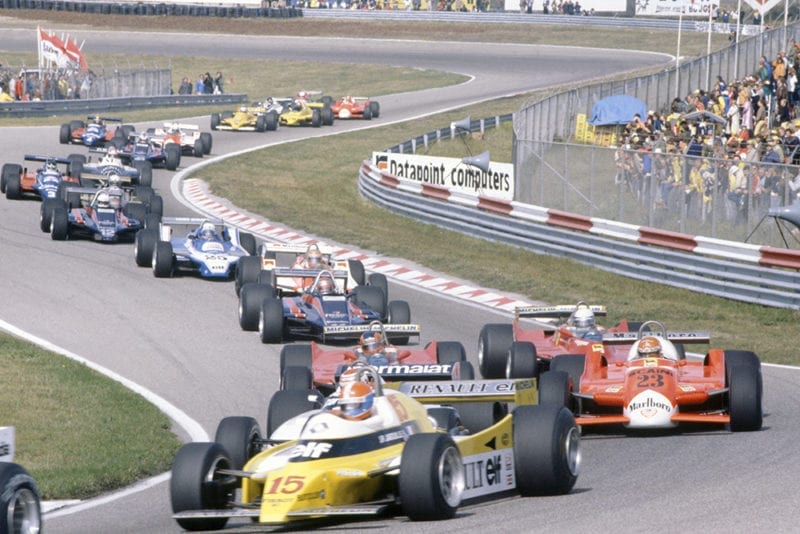
Renault’s Jean-Pierre Jabouille heads the pack in shot at the start
Motorsport Images
To say that the rain came down on Sunday morning would have put it mildly, you would have thought the sea had overflowed! The weather forecasters promised that all would be sunshine and bright by mid-day, but no-one really believed them. In Holland you are not allowed to cause a public disturbance before mid-day on Sunday, and the noise of racing engines is considered to be a disturbance, so the pre-race warm-up half-hour could not take place until 1 p.m., the race being due to start at 3 p.m. Everyone hoped for no trouble, for they had enough problems trying to gauge what the weather was going to do and what tyres and gear ratios to use, for the strong wind had turned through 180-degrees and was now a head-wind on the main straight instead of the tail-wind it had been for the past two days. When the warm-up began the rain had stopped and the wind was drying the track as you watched, so that though some drivers set off on wet-weather tyres they were soon in the pits to change over to “slicks”. Jones was still in the Williams T-car though the newly-built one was standing by ready to go, Piquet’s spare car had been converted back to a Hewland gearbox and appropriate rear suspension, Mansell was back in Lotus 81/B as the T-car had to be kept available for Andretti, in case of any last minute problems with 81/1 and everyone else seemed to be in pretty good order. As predicted the sun appeared, everything dried up and the wind settled down to a still breeze and there were sighs of relief all round as preparations were made for a “dry” race, and some teams were having final thoughts on gear ratios.
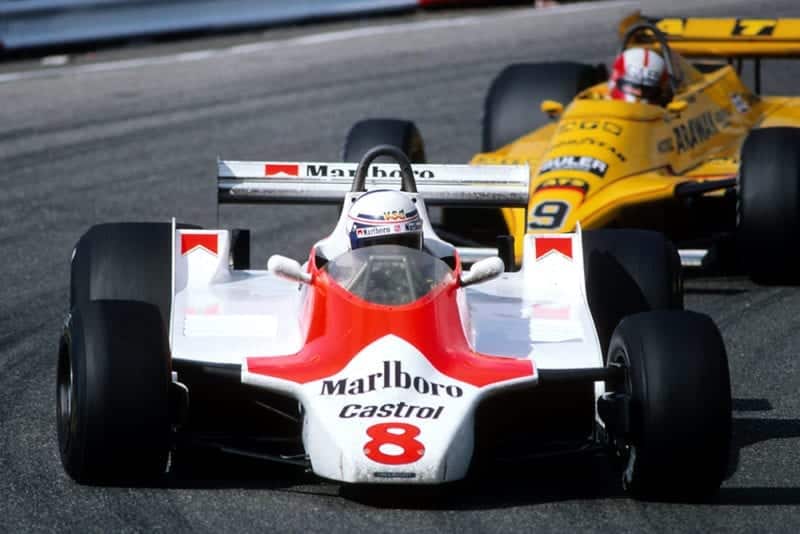
Alain Prost took a sole championship point for McLaren
© Motorsport Images
Well on time the cars left the pit lane one at a time and were driven round to the assembly-grid in front of the main grandstand, Piquet, Reutemann, Pironi and de Angelis all pulling off into the pit-lane either for a quick word with their staff, a minor adjustment, or merely to sneak in another warm-up lap. The front of the grid looked pretty orthodox, but it was a change to see Villeneuve and Watson so well placed, and Giacomelli’s position was something we are becoming accustomed to. Brambilla had qualified the second Alfa Romeo quite comfortably, on his first appearance for nearly a year, which should have made the non-qualifiers think a bit. As 3 p.m. approached engines were started and the green flag waved to set the field off on its parade lap behind the two Renaults, ready for the start of the 72-lap race. All twenty-four cars lined up correctly on the starting grid, in two staggered rows, with Arnoux at the front and when the green light shone they all made superb starts, though some were better than others. Zandvoort always provides an exciting “drag-race” down to the right-hand sweeping hairpin of the Tarzan corner, the track being very wide all the way round, with quite a steep banking so that all manner of liberties can be taken in the opening rush, and they were. Arnoux was well away but Jabouille’s engine hung-fire as he changed into second gear and Jones was past him on the outside and side-by-side with Arnoux as they turned into the corner. Jones clung to the top of the slight banking, right round the outside of the Renault and dived down into the lead as they left the corner. Laffite and Reutemann both passed the hesitant Jabouille and everyone streamed round the hairpin behind the pits and up over the hill across the sand dunes.
By the end of the opening lap Alan Jones had a surprising lead, surprising to him as well, for he expected the Renaults to power by down the long straight. As he started lap 2 he was thinking “it shouldn’t be this easy…” and rounding the tight hairpin behind the pits he looked in his left-hand mirror to see where the Renaults were. That was his big mistake. While thinking about what was happening behind him he let the Williams slide too far to the right as he left the hairpin and he skated over the bevelled kerb and smashed the right-hand sliding-skirt as he came back onto the track. As he took the next left-hand bend he could feel the car was unbalanced and realised he had done some damage. He still led through the back sweeps and onto the straight, but then headed for the pit-lane, furious with himself as he watched Arnoux, Laffite, Reutemann, Jabouille, Piquet, Villeneuve, Giacomelli, Andretti and the rest go by.

Alfa Romeo’s Vittorio Brambilla crashed out on lap 21
© Motorsport Images
As they plunged off on the third lap Jones stopped at his pit, pointing to the right side of the car, and his mechanics went into action removing the side panels, detaching the damaged skirt and its spring mechanism and fitting a new one. On lap 3 Laffite overtook Arnoux, while Jabouille overook Reutemann as did Piquet and Giacomelli, so we had French drivers and French cars in the first three places. Arnoux challenged briefly for the lead on lap 4, but failed and then settled into second place and as the leaders went by at the end of lap 5 the Williams mechanics finished their work and Jones fairly rushed back into the race. Not with the intention of some professional drivers in the past, who cruised round after such a long stop, but with the determination to “drive like hell and have a go”. He was a full three-and-a-half laps behihd when he rejoined the fray and lesser men would have given up and gone off for a beer. While all this had been happening there had been disasters all round. Rebaque retired at the pits at the end of the first lap with gearbox trouble, de Angelis had been forced to dodge Patrese and in doing so collided with Pironi and Jabouille’s Renault was feeling very unbalanced and he pulled into the pits at the end of lap 6. All four tyres were changed and he set off again to see if the Michelins were the trouble. This had let the remarkable Villeneuve into third place, the Canadian driving with all his natural vigour even though he knew the Ferrari would use up its Michelins betore very long, while immediately behind him Nelson Piquet was settling in nicely, his Brabham BT49 feeling absolutely right. On lap 7 he took third place from Villeneuve and pulled away to join Laffite and Arnoux and by ten laps these three were out on their own and Giacomelli now passed Villeneuve and Reutemann lined himself up to do the same. With the race barely settled down we had lost Rebaque, de Angelis and Pironi, while Fittipaldi was in the pits with brake trouble and Jabouille and Jones were far behind. Laffite still led from Arnoux and Piquet but then there was a gap before Giacomelli appeared in fourth place, leading Villeneuve, Reutemann, Andretti, Watson and Jarier, then another gap to the odds and ends at the back of the field, led by Patrese with Scheckter, Daly, Prost, Cheever, Surer, Mansell, Lees and Brambilla following. As Scheckter came in to change tyres Piquet moved up into second place and at the end of lap 12 the young Brazilian driver sat it out side-by-side with Laffite down past the pits into the Tarzan braking area. He was on the bumpy inside line and the Brabham was pitching horribly but Piquet was determined and as they stood on the brakes he was in the lead and away, after a brave and decisive manoeuvre.
Arnoux was not completely happy for his Renault had more brake balance to the rear wheels than he would have liked, which meant he could not take liberties under braking. Although there is a cockpit control for altering the front-to-rear brake balance be had been warned severely not to use it, because the last time he had altered it during a race he had got muddled and turned it the wrong way. Consequently, when he was pressured by Giacomelli he had to give way, which dropped him back to fourth place, ahead of Reutemann and Andretti. Trouble was still rife back down the field, Mansell had spun off when his brakes failed on the Lotus 81/B, Watson’s brief moment of glory faded when his Cosworth V8 started to vibrate dramatically, forewarning of an imminent blow-up, so he retired immediately, Jabouille had tried yet another set of tyres with no improvement to the handling so now the differential was suspected as being the cause of the trouble, and Fittipaldi came creeping back into the pits still in trouble with brakes; right under his rear aerofoil was the Ferrari of Villeneuve, eager to get to his pit for another set of Michelin tyres. Meanwhile Alan Jones was pounding on really hard and was amongst the tail enders who could have been excused for thinking he was leading at a furious pace, if they had not seen him go into the pits. He was still three laps behind the leaders, but it did not diminish his pace “. . .I came here to drive a racing car. . . .”
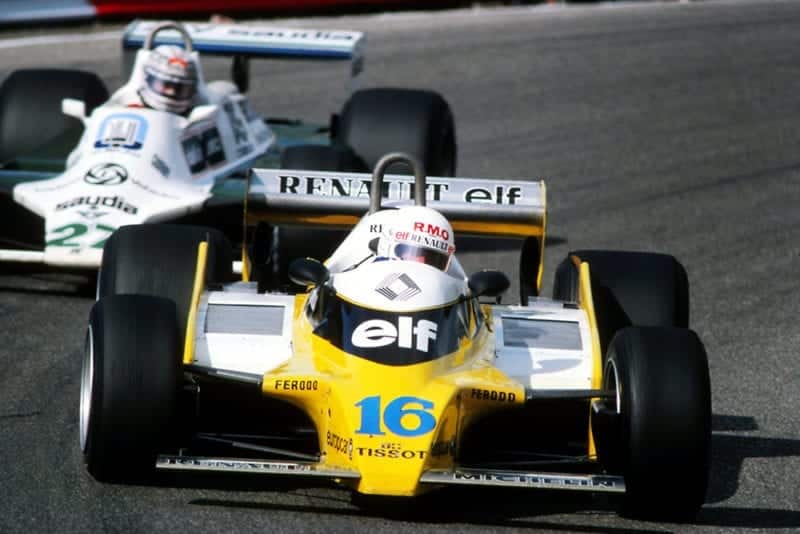
Rene Arnoux keeps his Renault ahead of Jones
© Motorsport Images
Once past Laffite’s Ligier the Brabham team-leader pulled away relentlessly, driving beautifully and looking supremely confident, while Gordon Murray the designer and his pit-crew watched with satisfaction and kept their young star fully informed of his progress. For once Andretti was feeling happy and confident in his Lotus 81/1 and he showed this by passing Reutemann on lap 20 and then closing up on Arnoux to challenge for fourth place. Laffite was beginning to drop back a little and this encouraged Giacomelli to greater efforts and he began to close up on the Ligier and could see second place as a distinct possibility. As Surer went by on lap 29 making an awful noise from a split exhaust manifold on the ATS, Patrese retired his Arrows with a blown-up engine. Alan Jones was now closing up on the mid-field runners, but still three laps behind, and Reutemann made an attempt to outbrake Andretti for the Tarzan corner and failed miserably.
By half-distance, 36 laps, Piquet had it all sewn up barring trouble, for he was something like twelve seconds ahead of Laffite and running the race at his own pace. Giacomelli was within striking distance of second place and Arnoux was still holding fourth place ahead of Andretti, and Reutemann, while Jarier was keeping up with them. Then came Daly, Frost, Cheever and Surer, the two Ferraris being a lap behind due to their pit stops and Jones still three laps down. On the next lap Giacomelli was right up with Laffite and on the back of the circuit he tried to outbrake the Frenchman going into the second chicane, got all crossed up and bounced over the kerbs damaging the side-skirts. Meanwhile Reutemann had made another abortive attempt to outbrake Andretti going into the Tarzan corner, the Lotusi driver being in fine form and refusing to give way. Giacomelli’s mistake dropped him back to seventh place and the damage caused was to slow him up and eventually cause his retirement. While first and second places looked secure, third place was still wide open between Arnoux, Andretti and Reutemann and to add spice to the situation Alan Jones now caught up with this trio. For a while he sat behind Reutemann and then went by on lap 44 and Andretti thought he’d got double-vision when he saw a green and white Williams car in each mirror! While Reutemann had seemed content to follow the Lotus, Jones had other ideas and made to overtake, but Andretti was having none of it. He had no idea that Jones was three laps behind, he could have been on the same lap, and any Williams car was opposition to his fourth place. For three laps we had a good old battle, with no quarter given and none asked for, which must have upset some of the ex-drivers who now act as television commentators. At the end of lap 48 Jones got it just right and got by Andretti, wagging a finger at him as he did so, but it had been good clean racing, with both drivers having implicit faith, as you must do when you run that close to each other. Having been shown how to do it by his team-leader Reutemann passed Andretti as they started lap 51, thus taking fourth place, but with little hope of doing anything about Arnoux in third place.
Scheckter had stopped for another set of tyres and a few laps later Villeneuve also stopped for another set, it seeming odd that the Ferraris needed three sets of Michelins to do the race distance while Renault could run through non-stop on what appeared to be the same tyres. We were now approaching lap 60, with only twelve to go and Piquet was so confident out in front that he was able to ease off and take his time. At the end of lap 58 Giacomelli gave up the unequal struggle with his damaged Alfa Romeo and retired at the pits, while Daly went out of the race in his Tyrrell in a more spectacular fashion than he had done at Monaco earlier in the season. As he braked for the Tarzan corner to start lap 61 the left front brake disc shattered and tore one of the calipers from its mounting; the errant caliper flew out radially and punched a hole in the alloy wheel rim and went into the tyre. With no front brakes and a flat tyre the Tyrrell ploughed off across the sand, the wheel and hub assembly broke off, the left front corner dug into the sand and the car spun upwards to an incredible height and crashed down on top of the tyre barrier, fortunately the right way up. A rather shaken Irishman was helped out, with a slight cut on his leg and lots of bruises, justifiably wondering what had happened.
With ten laps left it now became noticeable that Arnoux was closing the gap between his Renault and Laffite’s Ligier, for now that most of the petrol load had been used up the Renault felt more stable under heavy braking so the wiry little Frenchman was piling on the steam. Jones, Reutemann and Andretti tried to stay with the Renault, but they couldn’t and the turbo-charged car drew away in pursuit of the Ligier. It all began to happen rather quickly and the Ligier pit did not alert their driver so that by lap 69 the Renault was in Laffite’s mirrors. At the end of the next lap it powered past into second place, Arnoux wisely waiting until the end of the long straight before he went by, thus preventing Laffite from diving into his slip-stream. Arnoux was now braking to the maximum and it was all over.
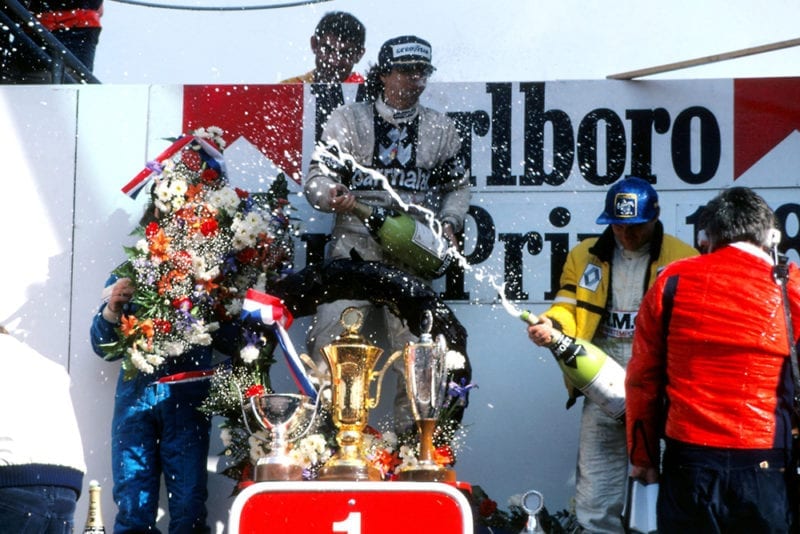
Piquet celebrates on the podium
© Motorsport Images
Piquet came home a worthy winner, having taken the lead from the opposition rather than inheriting it and once ahead no one had looked like troubling him. A chirpy Arnoux finished second, half-a-second ahead of Laffite and with a twinkle in his eye told his rival that he had “turned up the turbo-boost in the closing laps” but everyone knows the Renault runs on a fixed boost pressure. Reutemann was fourth and we waited for Andretti to finish a good fifth, but he never appeared. With half a lap to go the Lotus ran out of petrol. Cutting it fine is one thing, but this was ridiculous and it meant that Jarier, Prost and Villeneuve all went by the stricken Lotus, dropping it to eighth place. On the slowing down lap Jarier stopped and gave Andretti a lift back to the finish, but he was not too amused at Team Lotus. Alan Jones drove hard right to the end, having made up half a lap on the leaders and was not particularly overioyed at seeing Piquet on the winner’s rostrum as he was too close for comfort in the World Champion table. While Nelson Piquet acknowledged the applause Gordon Murray stood in the crowd below smiling contentedly, but there was no sign of the Brabham team owner Mr. Ecclestone, he seemed to have disappeared. — D.S.J. (Photographs appear on pages 1547 and 1551)
